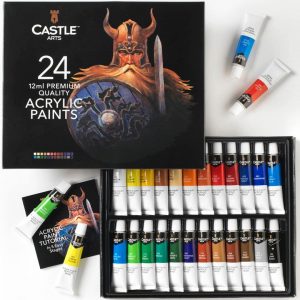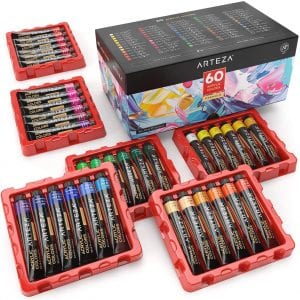The Best Acrylic Paint

Our Review Process
Don't Waste Your Money is focused on helping you make the best purchasing decision. Our team of experts spends hundreds of hours analyzing, testing, and researching products so you don't have to. Learn more.
Our Picks For The Top Acrylic Paints
- 1. Caliart Non-Toxic Brushes & Acrylic Paints, 24-Count
- 2. Castle Art Supplies Easy Squeeze Acrylic Paint Set, 24-Colors
- 3. MyArtscape Natural Buttery Acrylic Paints, 12-Count
- 4. Crafts 4 All Nontoxic Acrylic Paint Set, 60-Colors
- 5. Apple Barrel PROMOABI Easy Clean Acrylic Paints, 18-Count
- 6. Liquitex BASICS Adjustable Acrylic Paint Set, 6-Colors
- 7. Craft Smart Non-Toxic Acrylic Paint Set, 16-Colors
- 8. Magicfly Professional Easy Clean Acrylic Paints, 14-Count
- 9. Crafts 4 All Non-Toxic Satin Acrylic Paints, 12-Count
- 10. Sax True Flow Layering Washable Acrylic Paints, 6-Count
- 11. Benicci Beginner Mixing Acrylic Paint Set, 24-Colors
- 12. Liquitex BASICS Thick Easy Blend Acrylic Paint, 1-Count
- 13. Mont Marte Signature Acrylic Paint Set, 24-Colors
- 14. ARTEZA Vivid Artist Quality Acrylic Paints, 60-Count
- 15. GOTIDEAL Quick Dry Certified Acrylic Paints, 48-Count
- 16. Zenacolor Water Based Acrylic Paint Set, 20-Count
- 17. J Mark Canvas Washable Acrylic Painting Set, 12-Colors
These acrylic paints have a premium quality and glide on easily. They dry quickly with vibrant colors. The set comes with 24 colors and 12 brushes.
Premium QualityThese paints glide on smoothly and the craft supplies set includes 12 brushes.
With this acrylic paint set, you'll receive a total of 24 different colors that can be used on a variety of surfaces. The paint is designed to go on nice and smooth and the tube is easy to squeeze. Since the paint is quick to dry, it's perfect for projects that require layering.
Vibrant ColorsThis acrylic paint set is great for tweens, teens and young adults.
If you're searching for professional-grade acrylic paint without a hefty price tag, this option is an excellent choice. Each of the included 12 paints are bright and go on your canvas nice and thick. Since the paints are non-toxic, you can also use them to teach younger children a few fundamentals.
Nice and ThickUse this acrylic paint on metal, ceramic, canvas, paper and fabric.
With this acrylic paint set, you'll be able to tackle an endless number of projects. The paint works just as well on glass and tile as it does on canvas. Each set includes 20 fast-drying paints and three high-quality paintbrushes.
Budget-Friendly OptionThanks to the affordable price tag on this acrylic paint set, you'll be able to create an abundance of art without spending a fortune.
Buying Guide
Acrylic paints are one of the most popular and widely-used paints around. Acrylic paint is water-soluble, meaning you can be a little messy when you’re painting and the paint will still easily wash off of your skin, making it a fantastic product for crafts or to use with children who tend to get everything on themselves.
“This versatile paint is a favorite of fine artists and crafters alike,” says our arts and crafts expert Amy Markham, an artist, middle school art teacher and the creator of Starling, a podcast dedicated to helping artists develop depth in their creative practice.
Acrylic paint is a product that combines color pigments with a synthetic resin that is quick-drying.
“Once the paint dries, it is waterproof and can also be painted over,” says Markham. “There are a variety of price points and qualities of acrylic paints.”
Craft-level acrylic paints are generally the most affordable of the options you will see, but don’t let that discourage you from trying them out. A set of craft paints like the Crafts 4 All Non Toxic Acrylic Paint, 24-Count can give you a huge selection of colors to play with while not having to worry about wasting expensive paint.
“Craft-level acrylic paint comes in small bottles and are thinner in consistency than tube acrylics,” says Markham. “They are thinner because they contain less pigment and more water, which makes them inexpensive. Good for hobby level projects and crafts these paints can be used on a variety of surfaces, such as wood, fabric, paper and canvas.”
If you’re planning to use a lot of paint, whether it be for a group of people working in a classroom-like setting or a craft night with friends, there are sets of larger bottles of paint that offer more of each color paint in a quantity large enough to be a good value in bulk. Sets like these let you use more paint without fear of running low like the smaller tubes might make you feel, so if you know that you will be using a lot of paint, or even just keeping the paint for many future projects, you might be better off purchasing a set with larger bottles.
“These mid-grade paints are perfect for beginners and artists on a budget, but, once you have a feel for the process moving to artist-level paints is a good idea, especially if you plan to show or sell your work,” Markham says.
The bulk paint bottles do only offer basic colors that need to be blended together whenever you would like to achieve a color that is not offered. This mixing of paints to get the exact right color can be challenging to more intermediate artists that really desire the exact right color for each section of their painting. This is where a set of smaller tubes of paint can start becoming your friend. There are sets of artist-level paints that set themselves apart from student-level paints by offering a lightfastness rating on each tube, which tells you in a quantifiable method how long the paint should last after sitting on the canvas for years while ultraviolet light does its best to fade the finished paint. The second factor that you can look for on a tube of artist-level paint is whether or not it has a hue or a pigment as the source of its color.
“If the paint says hue on the tube, it implies that it is a synthetic color and not pure pigment,” says Markham. “Some pigments are rare and very expensive, so this allows a better price point. This does mean these paints will have lower color saturation and overall be less vibrant.”
Having a synthetic hue is not necessarily a bad thing for most artists. The rare pigments that are needed to make some of the finest artist-level paints are often times very expensive. It is common to find sets of paints that offer a myriad of different colors that one might like to use in their paintings. This variety of colors means you won’t have to mix the paints as much to find something suitable for your canvas, or whatever medium you might be painting on, which is a good thing due to how overmixed mid-level paints can often start turning into a muddy brown color that loses its vibrancy. If you can find a set of acrylic paints that offer multiple colors that you can envision yourself using, then it’s a good practice to start with the lower-priced set of synthetic hues and work with them until you find that your ability as an artist is limited by your paint, a distinction that may very well take many years of practice in your art.
Our Expert Consultant

Artist and art educator
Artist and educator Amy Markham is the creator of Starling, a podcast dedicated to helping artists develop depth in their creative practice. A graduate of Virginia Commonwealth University, Amy has been an art educator since 2001. Today, she teaches middle school art at a school outside of Memphis, Tennessee. Her personal artwork explores myth-making and symbolic understandings. Through her brand, Starling Creative Living, she leads others to explore art production as a method for enriching their life experience.
What to Look For
- Mixing cheaper paints together can often lead to finding less-than-perfect colors in the end. Markham points out a distinction in what makes craft-level paints hard to mix properly. “One thing to consider when using these is that they are often already tints and shades of colors, which gives artists a multitude of colors to choose from,” she says. “But this means they have already been mixed with white or black to make the colors you are getting. Therefore, when you mix these you often will get muddy and dull colors.”
- You’ll be able to really make your painting pop off the page when you use acrylics, which can help you create depth of field and texture. “Another benefit of working with acrylics is the ability is the range of viscosity you can get with these paints. There are fluid acrylics and heavy body paints creating a range of fluidity from staining and washes to thick buttery application,” Markham says. “You can also mix these paints with a variety of acrylic mediums that can change the consistency of the paint. Mediums can help you build textures, create layers of transparent colors and make the work matte or glossy. These are a fun way to experiment in your painting process.”
More to Explore
One of the most expensive pigments around comes from the Lapis Lazuli. This semi-precious stone is a deep-blue metamorphic rock found in remote areas of Afghanistan. The richness of the blue in this rock has made it famous for its pigmentation from the time it was first discovered.
The rock boomed in popularity during the renaissance when the most famous painters of the era would keep the Ultramarine blue color, taken from the powder of finely-ground Lapis Lazuli, to finish highlights at the center of their paintings.
This finely-ground Lapis pigment can cost upwards of $10,000 for a kilogram.



























